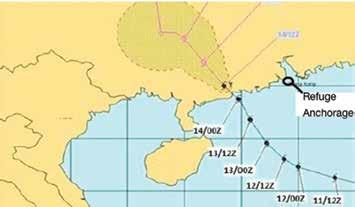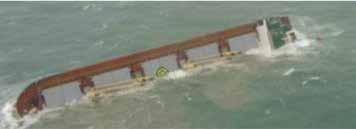201560 Unsafe cargo + unsafe anchorage = lost ship
Edited from Hong Kong SAR Marine Department Report, published 16 March 2015
A bulk carrier was to load a cargo of nickel ore from barges into five holds. During loading, which took approximately three weeks, intermittent rainfall caused interruptions in loading. The ore on the barges had to be covered over with tarpaulins and the holds on the vessel had to be closed. The crew of the vessel carried out a ‘can test’ of the ore on each barge before transfer to the vessel. If the test failed, an ‘oven drying test’ was done to determine the moisture content of the ore. If the moisture content was found to exceed the Transportable Moisture Limit (TML was 34.80%), the cargo in the barge would normally be rejected. However, records indicate that on at least two occasions cargo was accepted with moisture contents of 35.54% and 37% respectively. Once the loading was completed, the holds were trimmed and pressed by means of cargo grabs; each cargo hold was about half-full. Calculations showed the vessel’s intact stability met the requirements of the International Code on Intact Stability, 2008. About a week after departure the Master had to divert due to a typhoon, eventually dropping anchor at a port of refuge that offered protection from wind and seas from the north. The vessel was yawing and rolling heavily and dredging her anchor at the anchorage due to strong winds and heavy sea, now coming from the southeast. The following day, the vessel encountered a strong wave causing her to heel to port about 20°. The vessel returned somewhat upright but was still listing about 10° to port. Within two hours the list to port increased to 45° and then 90°. Soon afterward the vessel capsized and sank.
All crew successfully abandoned the vessel before sinking and were rescued without injuries. More than 600 tonnes of oil leaked into the sea and took more than three months to clean up. The investigation into the accident revealed several contributory factors including the following:
- Nickel ore was loaded despite a moisture content that exceeded its Transportable Moisture Limit, contrary to the requirements of the International Maritime Solid Bulk Cargoes Code (IMSBC Code).
- Several of the shipboard safety procedures for loading and carriage of nickel ore were not followed.
- Due to the heavy rolling at anchorage there was liquefaction of the ore cargo.
- The Master’s selected refuge anchorage was not appropriate as the location could only shelter from northerly wind and waves. The vessel experienced strong southeasterly wind and waves when the typhoon, as predicted, passed south and southwest of the vessel’s anchorage.
The investigation also revealed the following safety issues:
- The moisture content certificate of the nickel ore was issued by the shipper instead of the local administration or independent organisation (or authorised organisation)
- The crew was not trained and therefore not competent to carry out the oven drying test to verify the moisture content of the cargo before loading.
Editor’s note: Although ‘can tests’ can be used by crew to validate suspicions* that the moisture content of the ore may be above the certified TML, the oven drying test should be done in a laboratory. The Intercargo guide for transporting nickel ore, published in 2012, states: Where there is doubt concerning any cargo declaration information, or suspicion that the cargo has been misrepresented, independent cargo testing to determine the FMP, TML and actual moisture content of the cargo to be loaded should be carried out. The guide can be found here: http://www.gard.no/webdocs/ Intercargo_Nickel_Ore.pdf * For example, cargo that appears wet and/or splatters when loaded may raise suspicions that the moisture content of the ore may be above the certified TML.


